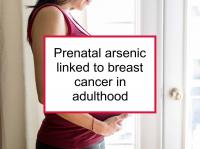Arsenic (As) exposure is associated with a variety of negative health effects. It appears to contribute to cardiovascular and lung diseases, type 2 diabetes, problems with brain development, and skin, bladder, and lung cancers. However, arsenic does not appear to be a major risk factor for breast cancer.
In fact, arsenic exposure has been reported to reduce breast cancer risk in some populations. However, a new study has reported that exposure to arsenic in the womb alters both the prepubertal and postpubertal development of the mammary gland in ways that could increase breast cancer risk.
Types of arsenic
Arsenic molecules are characterized as either organic (containing carbon) or inorganic (without any carbon atoms). Inorganic arsenic is linked to negative health effects. Arsenite (various inorganic arsenic compounds containing oxygen) has been shown to be estrogenic, with estradiol-like effects that activate the estrogen receptor. Arsenic trioxide (As2O3) is used as a cancer treatment and has been shown to induce apoptosis (programmed cell death) in breast cancer cells.
Sources of arsenic exposure
Arsenic is an element found at low levels in soil, water, and air. It is often found in drinking-water. Some man-made chemicals, including several pesticides, contain arsenic. However, food is the source of most human exposure. Plants take up arsenic from the soil and incorporate the element as they grow (it cannot be washed off or cooked out, for the most part). While inorganic arsenic is widespread in vegetables, fruit, grains and seafood, rice and apple juice are two common foods that can be concentrated sources, depending on their geographic origin. Unlike cadmium, arsenic does not build up in the body and is eliminated within days. Consumer protections against arsenic in food are weak.
Latest research finds prenatal exposure influences development
The study referenced at the beginning of this news article was designed to investigate the effects of prenatal exposure to arsenic in an animal model of mammary gland development. While early life exposure to estrogen and estrogenic compounds contribute to the risk of early puberty, thereby increasing breast cancer risk, the results of the present study demonstrate that exposure to arsenic also influences mammary gland development well before puberty.
In the study, in utero exposure to arsenite resulted in a greater number of mammosphere-forming cells, as well as increased branching, density, and number of epithelial cells in the prepubertal mammary gland. Prenatal exposure also resulted in the overexpression of estrogen receptor alpha (ERα) in the postpubertal gland. This overexpression was a result of an increased and altered response of ERα to estradiol.
The authors conclude that, in addition to advancing the onset of puberty, exposure to arsenite in the womb alters both the prepubertal and postpubertal development of the mammary gland and might increase the risk of developing breast cancer.
Please see our articles on the prenatal period and infancy for more information.
